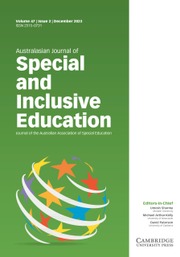Article contents
The Impact of Funding Models on the Education of Students With Autism Spectrum Disorder
Published online by Cambridge University Press: 24 May 2019
Abstract
Currently, there is no consensus as how best to fund inclusive education for students with autism spectrum disorder. In this narrative review, we examined a range of funding models internationally in an attempt to identify the range of best practices for resourcing inclusive education. Three databases were searched along with various policy documents to identify the range of existing funding models. Three models of input, throughput, and output funding were identified from which 7 key considerations were extrapolated to provide what was expected to be relevant information to policymakers, researchers, and educators seeking to discover effective ways to fund inclusive education for students with autism spectrum disorder.
- Type
- Review Article
- Information
- Australasian Journal of Special and Inclusive Education , Volume 43 , Issue 1 , July 2019 , pp. 1 - 11
- Copyright
- © The Author(s) 2019
Footnotes
The editorial review of this manuscript was managed solely by Michael Arthur-Kelly.
References
- 5
- Cited by


